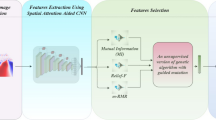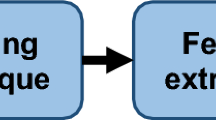Abstract
The separation and recognition of radar signals are crucial in a complex electromagnetic environment, especially multi-component radar signals. However, most existing algorithms can only recognize dual-component signals. An algorithm based on semantic segmentation is proposed to separate the signal in the time-frequency domain and classify multi-component radar signals. An improved Cohen class time-frequency distribution (CTFD) is used to represent the one-dimensional signals as time-frequency images (TFIs). A convolutional denoising autoencoder (CDAE) is established to filter the TFIs. Three semantic segmentation networks are used, a fully convolutional neural network (FCN-8s), U-Net, and DeepLab V3+. The method can separate and recognize signals simultaneously and is applied to aliased signals composed of 1-4 components. The simulation results show that the proposed method provides excellent performance for separating and recognizing multi-component signals. At a signal-to-noise ratio (SNR) of 0 dB, the accuracies of the aliased radar signals with 1-4 components are 100%, 100%, 96.67%, and 93.75%, respectively. The separation and recognition algorithm can be adapted to other signal modulation types.












Similar content being viewed by others
References
Yang, C., Feng, L., Zhang, H., He, S., & Shi, Z. (2018). A novel data fusion algorithm to combat false data injection attacks in networked radar systems. IEEE Transactions on Signal and Information Processing over Networks, 4(1), 125–136.
Ding, G., Wu, Q., Zhang, L., Lin, Y., Tsiftsis, T. A., & Yao, Y.-D. (2018). An amateur drone surveillance system based on the cognitive internet of things. IEEE Communications Magazine, 56(1), 29–35.
Dong, G., & Kuang, G. (2015). Classification on the monogenic scale space: application to target recognition in SAR image. IEEE Transactions on Image Processing, 24(8), 2527–2539.
Zheng, J., & Lv, Y. (2018). Likelihood-based automatic modulation classification in OFDM with index modulation. IEEE Transactions on Vehicular Technology, 67(9), 8192–8204.
Lin, Y., Tu, Y., & Dou, Z. (2020). An improved neural network pruning technology for automatic modulation classification in edge devices. IEEE Transactions on Vehicular Technology, 69(5), 5703–5706.
Wang, Y., Yang, J., Liu, M., & Gui, G. (2020). Lightamc: Lightweight automatic modulation classification via deep learning and compressive sensing. IEEE Transactions on Vehicular Technology, 69(3), 3491–3495.
Peng, S., Jiang, H., Wang, H., Alwageed, H., Zhou, Y., Sebdani, M. M., & Yao, Y.-D. (2018). Modulation classification based on signal constellation diagrams and deep learning. IEEE Transactions on Neural Networks and Learning Systems, 30(3), 718–727.
Lin, Y., Tu, Y., Dou, Z., Chen, L., & Mao, S. (2020). Contour stella image and deep learning for signal recognition in the physical layer. IEEE Transactions on Cognitive Communications and Networking, 7(1), 34–46.
Tu, Y., Lin, Y., Hou, C., & Mao, S. (2020). Complex-valued networks for automatic modulation classification. IEEE Transactions on Vehicular Technology, 69(9), 10085–10089.
Lin, Y., Zhu, X., Zheng, Z., Dou, Z., & Zhou, R. (2019). The individual identification method of wireless device based on dimensionality reduction and machine learning. The Journal of Supercomputing, 75(6), 3010–3027.
Tu, Y., Lin, Y., Wang, J., & Kim, J.-U. (2018). Semi-supervised learning with generative adversarial networks on digital signal modulation classification. Computers Materials Continua, 55(2), 243–254.
Baltrušaitis, T., Ahuja, C., & Morency, L.-P. (2018). Multimodal machine learning: a survey and taxonomy. IEEE Transactions on Pattern Analysis and Machine Intelligence, 41(2), 423–443.
Zhang, Z., Wang, C., Gan, C., Sun, S., & Wang, M. (2019). Automatic modulation classification using convolutional neural network with features fusion of SPWVD and BJD. IEEE Transactions on Signal and Information Processing over Networks, 5(3), 469–478.
Ni, X., Wang, H., Meng, F., Hu, J., & Tong, C. (2021). LPI radar waveform recognition based on multi-resolution deep feature fusion. IEEE Access, 9, 26138–26146.
Gao, J., Shen, L., & Gao, L. (2019). Modulation recognition for radar emitter signals based on convolutional neural network and fusion features. Transactions on Emerging Telecommunications Technologies, 30(12), e3612.
Hou, C., Liu, G., Tian, Q., Zhou, Z., Hua, L., & Lin, Y. (2022). Multi-signal modulation classification using sliding window detection and complex convolutional network in frequency domain. IEEE Internet of Things Journal. https://doi.org/10.1109/JIOT.2022.3167107
Liu, Z., Li, L., Xu, H., & Li, H.: A method for recognition and classification for hybrid signals based on deep convolutional neural network. In: 2018 international conference on electronics technology (ICET), pp. 325–330 (2018). IEEE
Qu, Z., Hou, C., Hou, C., & Wang, W. (2020). Radar signal intra-pulse modulation recognition based on convolutional neural network and deep q-learning network. IEEE Access, 8, 49125–49136.
Cheng, Y., Shao, J., Zhao, Y., Liu, S., & Malekian, R. (2019). An improved separation method of multi-components signal for sensing based on time-frequency representation. Review of Scientific Instruments, 90(6), 064901.
Chen, S., Dong, X., Xing, G., Peng, Z., Zhang, W., & Meng, G. (2017). Separation of overlapped non-stationary signals by ridge path regrouping and intrinsic chirp component decomposition. IEEE Sensors Journal, 17(18), 5994–6005.
Feng, Z., Liang, M., & Chu, F. (2013). Recent advances in time-frequency analysis methods for machinery fault diagnosis: a review with application examples. Mechanical Systems and Signal Processing, 38(1), 165–205.
Yu, J., & Zhou, X. (2020). One-dimensional residual convolutional autoencoder based feature learning for gearbox fault diagnosis. IEEE Transactions on Industrial Informatics, 16(10), 6347–6358.
Lundén, J., & Koivunen, V. (2007). Automatic radar waveform recognition. IEEE Journal of Selected Topics in Signal Processing, 1(1), 124–136.
Qu, Z., Mao, X., & Deng, Z. (2018). Radar signal intra-pulse modulation recognition based on convolutional neural network. IEEE Access, 6, 43874–43884.
Zhang, Y., Xiao, J., Peng, J., Ding, Y., Liu, J., Guo, Z., & Zong, X. (2018). Kernel wiener filtering model with low-rank approximation for image denoising. Information Sciences, 462, 402–416.
Wu, Q., Li, Y., & Lin, Y. (2017). The application of nonlocal total variation in image denoising for mobile transmission. Multimedia Tools and Applications, 76(16), 17179–17191.
Zhao, W., Liu, X., Wang, S., Fan, X., & Zhao, D. (2019). Graph-based feature-preserving mesh normal filtering. IEEE Transactions on Visualization and Computer Graphics. https://doi.org/10.1109/TVCG.2019.2944357.
Long, J., Shelhamer, E., & Darrell, T.: Fully convolutional networks for semantic segmentation. In: Proceedings of the IEEE conference on computer vision and pattern recognition, pp. 3431–3440 (2015)
Ronneberger, O., Fischer, & P., Brox, T.: U-net: Convolutional networks for biomedical image segmentation. In: International conference on medical image computing and computer-assisted intervention, pp. 234–241 (2015). Springer
Chen, L.-C., Zhu, Y., Papandreou, G., Schroff, F., & Adam, H.: Encoder-decoder with atrous separable convolution for semantic image segmentation. In: Proceedings of the European conference on computer vision (ECCV), pp. 801–818 (2018)
Simonyan, K., & Zisserman, A.: Very deep convolutional networks for large-scale image recognition. arXiv preprint arXiv:1409.1556 (2014)
Chen, L.-C., Papandreou, G., Schroff, F., & Adam, H.: Rethinking atrous convolution for semantic image segmentation. arXiv preprint arXiv:1706.05587 (2017)
Lin, T.-Y., Goyal, P., Girshick, R., He, K., & Dollár, P.: Focal loss for dense object detection. In: Proceedings of the IEEE international conference on computer vision, pp. 2980–2988 (2017)
Pan, Z., Wang, S., Zhu, M., & Li, Y. (2020). Automatic waveform recognition of overlapping LPI radar signals based on multi-instance multi-label learning. IEEE Signal Processing Letters, 27, 1275–1279.
Si, W., Wan, C., & Zhang, C. (2021). Towards an accurate radar waveform recognition algorithm based on dense CNN. Multimedia Tools and Applications, 80(2), 1779–1792.
Lin, Y., Zhao, H., Ma, X., Tu, Y., & Wang, M. (2020). Adversarial attacks in modulation recognition with convolutional neural networks. IEEE Transactions on Reliability, 70(1), 389–401.
Sun, J., Wang, W., Kou, L., Lin, Y., Zhang, L., Da, Q., & Chen, L. (2020). A data authentication scheme for UAV ad hoc network communication. The Journal of Supercomputing, 76(6), 4041–4056.
Wang, M., Lin, Y., Tian, Q., & Si, G. (2021). Transfer learning promotes 6g wireless communications: recent advances and future challenges. IEEE Transactions on Reliability. https://doi.org/10.1109/TR.2021.3062045.
Author information
Authors and Affiliations
Corresponding author
Additional information
Publisher's Note
Springer Nature remains neutral with regard to jurisdictional claims in published maps and institutional affiliations.
Rights and permissions
Springer Nature or its licensor holds exclusive rights to this article under a publishing agreement with the author(s) or other rightsholder(s); author self-archiving of the accepted manuscript version of this article is solely governed by the terms of such publishing agreement and applicable law.
About this article
Cite this article
Hou, C., Fu, D., Hua, L. et al. The recognition of multi-components signals based on semantic segmentation. Wireless Netw 29, 147–160 (2023). https://doi.org/10.1007/s11276-022-03086-7
Accepted:
Published:
Issue Date:
DOI: https://doi.org/10.1007/s11276-022-03086-7




